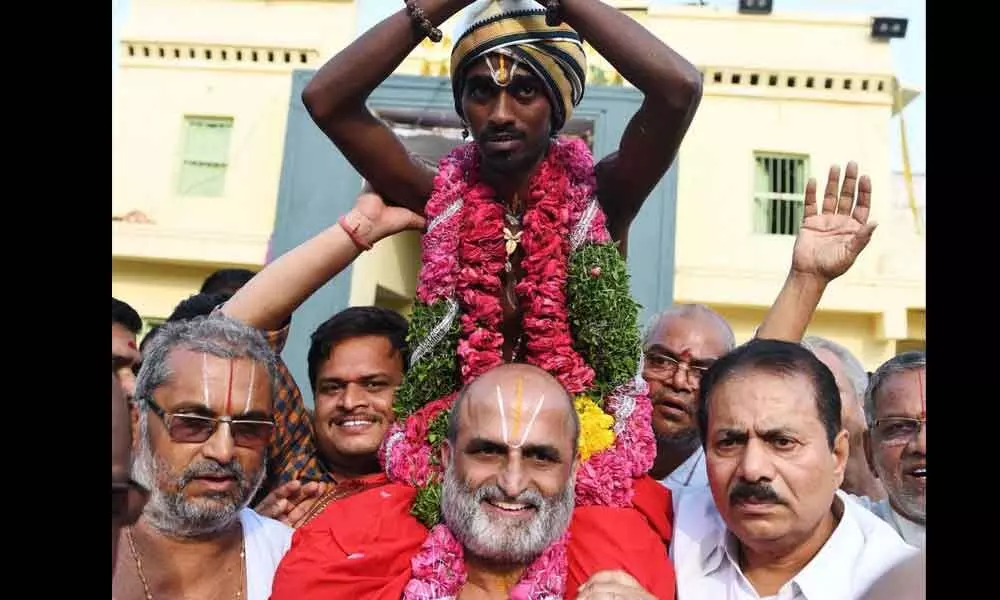Demystifying the 'superior' status of Brahmins…

Demystifying the ‘superior’ status of Brahmins
Further to the article on Brahmin Welfare Corporations on the editorial page (THI, October 1), it is unfortunate that Brahmins have faced a strong antipathy for centuries.
Further to the article on Brahmin Welfare Corporations on the editorial page (THI, October 1), it is unfortunate that Brahmins have faced a strong antipathy for centuries.
The basic Brahminical account standing rock like from 17th century European narratives to present day 'scientific' explanations is this: 'As a priesthood, the Brahmins mediate between the devotees and their deities by sacrificial rituals.
They are the creators of a four-tiered hierarchy of classes, assigning the highest status to their own priestly class and the lowest to the Sudra or servant class.
Traditionally, the learned Brahmin is the recipient of many privileges. Lacking military prowess and political-economic power, the minority Brahmins drew on their ritual status to seek a special alliance with the warrior-ruler class.
They reduced the lower castes to a state of subjugation by imposing many restrictions like denying access to the Vedas and treating them as impure or untouchable, and preventing upward mobility between castes.'
Our textbooks describe the Brahmins as oppressors, exploiters, and creators of the caste system. The Left- influenced academia with their theories of exploiter and the exploited, the missionaries, and the brainwashed intellectuals continued the British story post-independence.
Brahmins were neither rich nor powerful at any point of time in history. The present social sciences just build up data to show the validity of previous truths; rarely, do they turn back to reflect that these narratives could be false too.
Dharampal (The Beautiful Tree) deconstructs the popular idea that education was the exclusive domain of high caste Brahmins, who denied education to others, based on reports commissioned by the British themselves.
A survey from 1822 to 1825 in the Madras Presidency showed that the predominant castes in schools were the Sudras. In the Tamil areas, the composition of the school going children was forward castes, 13-23 per cent; Muslims, 3-10 per cent; and Sudras and other castes, 70-84 per cent. In Malabar areas, the forward castes were 20 per cent, Muslims 27 per cent, and Sudras about 50 per cent.
Another report in 1825 showed that out of 1,88,680 scholars in Madras Presidency, Brahmins were 23 per cent and Sudras 45 per cent. In Telugu areas, Brahmins were between 24-46 per cent, and Sudras between 35-41 per cent.
This is a problem for British historiography because the literacy rate when they left India was about 12 per cent. It was not the outcome of the forward castes 'denying' others the access to education but the replacement of the traditional and classical education system by the Anglicised education.
Many thousands of Brahmins lost their lives in the Islamic invasions and the Goan Inquisitions as they were the primary target of the ire of the invaders. Francis Xavier made his position clear when he wrote to the king of Portugal, his patron, 'If there were no Brahmins, all pagans would be converted to our faith', calling them the 'most perverse people.'
In many feudalistic excesses, many non-Brahmin communities as land owners were responsible for oppression of the deprived. Somehow, our social sciences ensured that Brahmins became the prime villains in society.
Meenakshi Jain writes that Brahmins were prominent in the freedom movement confirming the worst British suspicions of the community. Even though for centuries Brahmins and non-Brahmins had been active political and social partners, the fissures grew by the machinations of the British.
Some British observers like Colebrooke concede that there was little difference in the condition of the Brahmin and the rest of the native population. The British census operations, especially that of Risley (1901), were determined to show race as the basis for the caste-system.
The British census operations destroyed the flexible jati-varna system and raised caste consciousness to a feverish pitch, inciting animosities, and a general hardening of the system. Caste consequently became a tool in the political, religious, and cultural battles.
Post-independence, many studies have shown Brahmins to be in a continuous downward spiral mode. Land holdings have reduced. Traditional occupations like family and temple priesthood, recitation of the Vedas and practice of Ayurvedic medicine no longer prove remunerative nor command respect.
A few decades back (1978), the Karnataka state finance minister stated the per capita income of various communities: Christians 1,562; Vokkaligas Rs 914; Muslims Rs 794; Scheduled castes Rs 680; Scheduled Tribes Rs 577; and Brahmins Rs 537.
One study in the previous united Andhra Pradesh showed 55 per cent of them living below the poverty line, 10 per cent higher than other groups. The unemployment rate among them was as high as 75 per cent.
Such is the deep antipathy to Brahmin community that despite consisting of hundreds of jatis, with no uniform rules of living and social interaction, a success is a result of 'privilege' and individual faults project to the whole community across the length and breadth of the country.
Academia, media, NGO activists, and intellectuals project the Shramana (Buddhism and Jainism) and Bhakti movements as egalitarian anti-caste revolts carrying a 'millennial-long' conflict with Brahmanism and the 'tyranny of caste.'
This hypothesis places Buddha (Martin Luther of India) as the first reformer opposing corrupted Brahmanas and preaching the equality of man. Scholars have shown that Buddhists neither rejected Brahmanas nor did they fight against the 'caste system'. Buddha and Buddhists considered varna divisions to be an appropriate dharmic grouping of society. Buddhism was just another tradition in the Hindu land where new traditions, sects, and gurus evolve all the time showing many paths to the final enlightenment.
Unbroken, this narrative about the wily Brahmins continues prominently in introductory works, encyclopaedia entries, and other sources as elementary facts about Indian culture and religion.
The Balagangadhara school shows that Christian-theological ideas concerning heathen priesthood and idolatry; Aryan racial notions of biological and cultural superiority and inferiority; and anthropological speculations about 'primitive man' and his 'magical thinking' explained the role of Brahmins in Indian society till about three decades back.
These concepts, crucial to the speculations about the Brahmin priesthood rise, reflected Protestant and philosophical critique of priesthood pervading 18th- and 19th-century Europe. Imre Lakatos, 20th-century philosopher of science, characterised every research programme as having three elements: a 'hard core' of basic theses and assumptions; a 'protective belt' of auxiliary hypotheses surrounding this core; and a 'heuristic' or problem-solving machinery.
The protective belt allows it to cope with the problems by immunizing its hard core against falsification.
Jakob De Roover says that the basic assumptions about the religion of the Brahmin are part of this program's hard core, whereas the claims concerning the Aryan invasion, racial superiority, magical thinking, and the varna ideology are part of its protective belt.
The British attacked Brahmins for many reasons, but it is sad that our politicians, social sciences, and society failed to look beyond what the colonials said even after seven decades of independence.














